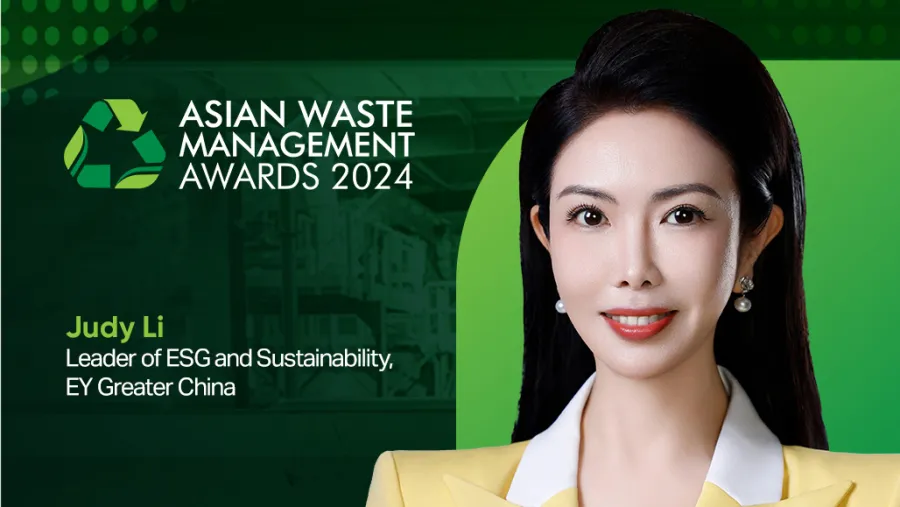
Integrate climate change into company’s long-term strategy to align with SDGs - EY’s Judy Li
Effective waste recycling and resource utilisation boost company sustainability and offer new approaches to global waste management.
As demand for sustainable and ethical practices rises, companies are integrating ESG standards and practices to mitigate risks, capitalise on new opportunities, and play a crucial role in shaping industry benchmarks and regulatory requirements.
Offering valuable insights into this evolving landscape is Judy Li, Sustainability Services Partner for Financial Services at Ernst & Young Hua Ming LLP. She is also the Head of the ESG Management Office in EY Greater China and the EY Asia-Pacific Leader of Sustainability for Financial Services. Her extensive expertise encompasses ESG, decarbonisation, climate change management, green finance, and sustainable development.
Li provides clients with service and technical support in ESG, green finance, and carbon neutrality. Her services include strategic planning and implementation paths to achieve carbon neutrality goals, greenhouse gas inventory, energy conservation and emission reduction suggestions, green finance product certification and innovation, the EY green finance management system, ESG investment consulting, ESG strategic planning, and ESG information disclosure.
Her contributions extend to being an ESG expert and advising on ESG policies, standards, and research. She is also a distinguished public speaker and key opinion leader in ESG education, known for her keynote addresses at national forums and conferences.
As a judge at the Asian Waste Management Awards 2024, Li discusses how companies should incorporate their company’s long-term strategy with climate change to align their overall ESG practices with sustainable development goals (SDGs).
In your opinion, what are some of the most significant changes or advancements in ESG policies and standards?
On June 26th last year, ISSB released the first two sustainability disclosure standards. Over the past year, significant progress has been made in the adoption and use of various jurisdictions worldwide. Both Chinese regulatory authorities and the market are highly concerned about the implementation of the ISSB standards. On May 27th of this year, the Chinese Ministry of Finance officially released the Corporate Sustainability Disclosure Standards - Basic Principles (Draft for Comments), marking the official start of the construction of a unified sustainable disclosure standard system in China. This standard not only clarifies the purpose, scope of application, disclosure objectives, principles, quality requirements, and elements of sustainable disclosure for companies, but also provides a clear and comprehensive framework for sustainable information disclosure for companies. The draft of the Basic Principles reflects an international perspective and Chinese characteristics. On the one hand, the draft of the Basic Principles is based on the International Financial Reporting Sustainability Disclosure Standards, which provide principled provisions for the disclosure of sustainable information by companies, whilst specific thematic standards do not make specific requirements. At the same time, it maintains overall alignment with the requirements of the International Financial Reporting Sustainability Disclosure Standards in terms of disclosure elements, facilitating convergence between China's sustainability disclosure standards and international standards. On the other hand, the draft of the Basic Principles combines the beneficial experience of sustainable disclosure standards in international financial reporting with China's national stages and makes specific provisions that fully meet the national conditions in terms of formulation basis, disclosure objectives, importance principles, and institutional structure.
In addition to China, the Singapore Sustainability Report Advisory Committee (SRAC) has released a consultation document titled Turning Climate Ambition into Action to solicit opinions on the adoption of IFRS S2 standards in the Singapore market. The Hong Kong Stock Exchange has also published a consultation document on climate information disclosure under the framework of optimising the environment, society, and governance, recommending the introduction of new climate-related information disclosure requirements that comply with the ISSB climate guidelines to solicit market opinions. This March, the Japan Sustainable Development Standards Board (SSBJ) announced the release of a proposed draft of guidelines for companies to report sustainability and climate-related information in accordance with the recently released Sustainability Disclosure Standards by the International Sustainability Standards Board (ISSB). This marks a step forward for Japanese-listed companies towards mandatory standardisation of sustainability-related disclosures.
It is worth mentioning that in April this year, under the unified deployment of the China Securities Regulatory Commission, the three major stock exchanges in Shanghai, Shenzhen, and Beijing released the Guidelines for Self-discipline Supervision of Listed Companies - Sustainable Development Report (Trial), marking a new stage of development for ESG information disclosure in A-shares. This is not only a deep implementation of the concept of sustainable development in the Chinese capital market but also reflects the continuous maturity and standardisation of Chinese companies in practising ESG practices. The formulation and release of China's unified national sustainable disclosure standards will have a positive effect on promoting Chinese companies to practise the concept of sustainable development, better participate in global economic and trade investment activities, enhance international competitiveness, and promote high-quality development. It is also an inevitable trend to strengthen the basic institutional construction of a high-standard market system that is deeply integrated with international rules and to promote institutional opening and reform in the field of sustainable disclosure.
What future innovations or technologies do you think will play a crucial role in helping financial institutions achieve their decarbonisation goals?
According to the business characteristics of financial institutions, carbon neutrality can also be divided into two parts: operation carbon neutrality and business carbon neutrality. Operation carbon neutrality focusses on the emissions generated by office operations, which mostly belong to scope 1 and scope 2, and may also involve scope 3, such as emissions from employee air travel. Business carbon neutrality focusses on indirect emissions generated by financial assets, such as emissions from commercial bank credit customers and emissions from asset management institutions being invested in, which can all be classified as scope 3. The business model of financial institutions determines that their carbon emissions in scope 1 and 2 are not significant, mainly from energy consumption in office spaces, with a relatively small total amount. The key to decarbonising financial institutions is business carbon neutrality, which means greening the balance sheet.
Financial institutions face challenges in supporting green development, such as the large scale of green finance business, wide coverage of investment and financing industries, high professional requirements for risk quantification, and complex environmental benefit calculation data. It is urgent to improve the ability to accurately identify green projects, quickly screen and monitor carbon emission data, and quantify environmental and climate risks. Fintech can play a huge role in serving green asset identification, carbon accounting, and environmental information disclosure. Digital intelligent management systems will achieve more accurate, efficient, and intelligent information processing functions, improving environmental risk and opportunity management capabilities.
Based on its experience in green finance services, data accumulation, and leading position in the industry, EY has developed a green finance online management system with independent intellectual property rights using technologies such as artificial intelligence and big data analysis, combined with its technological advantages in the field of financial technology. This system helps financial institutions pay attention to their own ESG performance whilst supporting the identification of green industry projects and enhancing their green finance data management and analysis capabilities, thereby assisting financial institutions in achieving business decarbonisation and growing together with the development of their green business.
What are the key elements of an effective climate change management strategy, and how can clients ensure that these elements align with their overall sustainability goals?
The key elements for companies to implement effective climate management include assessing climate risks, setting climate targets and emission reduction routes, disclosing climate information, and communicating with stakeholders.
Understanding of climate risks: Companies need to have a deep understanding and recognition of climate risks, identify, analyse, and manage climate risks and opportunities to develop corresponding management strategies.
Developing short-, medium-, and long-term goals: Companies should conduct carbon inventory checks, calculate corporate carbon footprints, set greenhouse gas emission reduction targets that comply with the Paris Agreement, develop decarbonisation plans based on industry characteristics, and regularly track indicator progress.
Strengthening carbon management and carbon information disclosure: With the increasing international requirements for climate change-related information disclosure, companies need to actively prepare and disclose relevant climate information to comply with regulatory requirements and enhance transparency.
Stakeholder communication: Companies need to work closely with stakeholders and establish effective coordination mechanisms. By promoting collective participatory decision-making, companies can facilitate communication with stakeholders and gain broader public support, thereby accelerating climate action.
The key to aligning climate strategy with overall sustainable development goals is to incorporate climate change into the company's long-term strategy and work plan and achieve coordinated economic, social, and environmental development through the implementation of specific measures and strategies. For example, by adopting clean energy and improving energy efficiency, companies can reduce their dependence on fossil fuels and increase the development and utilisation of renewable energy sources such as solar, wind, and hydropower. This not only helps reduce greenhouse gas emissions but also promotes sustainable economic development.
What are the latest green finance practices that you find most promising or impactful, and how should companies leverage these to enhance their sustainability efforts?
Transition finance is a concept where financial services are provided to high-carbon-emitting industries – such as coal-fired power generation, steel, cement, chemical, papermaking, aviation, and construction – to fund the transition to decarbonisation. The transition finance concept emerged from the understanding that effective decarbonisation of the entire global economy will require much more than green finance. Green finance and sustainable finance have focussed largely on supporting activities that involve minimum pollution and carbon emissions. However, a much larger amount of financing is required in carbon-intensive sectors that need to decarbonise and eventually achieve net zero emissions. Internationally, many regulatory agencies have proposed their definitions, classification schemes, evaluation principles, and disclosure requirements for transition finance, and international organisations have also provided normative guidance documents.
Transition finance mainly involves four aspects: transition loans, transition bonds, sustainability-linked loans, and sustainability-linked bonds. These financial instruments have specific fund uses, specifically providing loans and bond financing for certain transition projects. For example, funds from transition loans and transition bonds are used to support specific transition activities of companies or projects, such as reducing carbon emissions and improving energy efficiency. Although sustainability-linked loans and bonds do not specify specific purposes, they require entities to have strict and high-standard transitional plans and evaluate transition performance through the development of key performance indicators. The design of these financial instruments aims to incentivise companies to achieve their transition goals, such as reducing carbon emission intensity. If companies fail to meet their targets, they will be subject to penalties. In addition, transition finance emphasises fair transition, meaning that companies need to take social responsibility during the transition process, such as providing employee re-employment and retraining programmes, which can help reduce social instability factors during the transformation process.
Currently, Chinese commercial banks are also exploring how to provide low-cost funding for the low-carbon transition of high-carbon-emitting industries within the framework of transition finance. For example, industries such as steel and cement can deploy low-carbon technologies on a large scale through preferential funds provided by commercial banks, such as lower interest rate transition loans, to achieve product upgrades and replacements.
Given your experience with ESG standards and research, how do you see the evolution of global ESG standards impacting waste management practices across the diverse landscapes of Asia?
The ESG concept promotes the efficient utilisation of resources and sustainable development of the environment, thereby facilitating the improvement and optimisation of waste management. The ESG concept emphasises that whilst pursuing economic benefits, companies should also consider their impacts on the environment and society and the rationality of their corporate governance structure. For example, the three major stock exchanges in China have released the Guidelines for Self-discipline Supervision of Listed Companies - Sustainable Development Report (Trial), which clarifies the issues of environmental, social, and corporate governance disclosure. In terms of the environment, the main consideration is the impact of companies on the environment, such as how companies manage and control the discharge of various pollutants during the production process (including direct pollution generated by their own production and operation and indirect pollution generated by upstream and downstream), as well as the disposal methods of waste. The ESG concept encourages companies to achieve resource recycling and improve the level of waste resource utilisation and reuse through technological and model innovation.
In Asia, with the growth of the Asian economy and advancements in technology, ESG perspectives are becoming increasingly popular and accepted, whilst ESG practices in Asia are also driving global ESG development. The efforts of Asian companies in ESG, especially in innovation and practice of waste management, not only contribute to improving the sustainable development level of the region but also have a positive impact on a global scale. In terms of garbage disposal, Singapore takes the 3R principle (reduction, recycling, reuse) as the core, reducing the generation of garbage from the source and maximising the recycling of garbage through resource utilisation. Japan has formulated the Circular Society Formation Promotion Law intending to build a circular society, clarifying the responsibilities and obligations of all members of society, and promoting the correct disposal of waste and environmental regeneration in accordance with the law, to achieve resource recycling throughout the entire life cycle. These practices not only embody the concept of ESG management but also provide feasible solutions for waste management in Asia and even globally. The impact of ESG management on waste management is gradually expanding in Asia. Taking effective measures to promote the recycling and resource utilisation of waste, not only helps to enhance the sustainable development capabilities of companies but also provides new ideas and methods for global waste management.
As an esteemed judge at the Asian Waste Management Awards 2024, what are the key factors you are looking for that companies should have in assessing their ESG and sustainability practices?
ESG, as a management tool for the sustainable development of companies, should be closely integrated into the strategy and operation of the companies. Companies not only need to disclose ESG information, but also pay attention to implementing ESG strategic planning, building ESG management system frameworks, ESG indicator systems, and other measures, striving to integrate ESG management with daily business activities from the dimensions of corporate governance, risk control, and information disclosure.
Firstly, companies need to develop ESG strategies and goals. ESG strategic planning includes identifying the company's mission, key risks and opportunities, and developing key performance indicators. From a strategic perspective, companies need to have ESG short-term, medium-term, and long-term development plans; set development metrics and goals for each stage in the short, medium, and long term; and implement relevant governance systems to ensure that the metrics and goals can be implemented.
Secondly, companies should strengthen ESG risk management. From the perspective of corporate governance, in recent years, regulatory requirements for environmental and social issues have significantly increased in business operations. Therefore, companies need to further enhance their supervision, governance, and cultural construction of ESG risks. Management needs to accurately identify the ESG risks they face and maximise opportunities in ESG-related activities based on a full understanding of ESG risks, to achieve corporate strategies or goals.
Finally, strengthen ESG information disclosure and improve disclosure quality. Information disclosure is the final and most important part of the ESG process. An excellent ESG report is not only a transcript of a company's sustainable development performance and an information medium for conveying the company's ESG performance, but also a communication and interaction window between the company and stakeholders, which can help stakeholders enter the company's ESG goals, measures, progress, and achievements. With the tightening of ESG regulatory policies, the importance and standardisation of ESG information disclosure continue to increase, whilst also exposing the existence of problems such as greenwashing. To prevent greenwashing behaviour, ESG assurance plays a key role in promoting companies to establish more rigorous ESG management systems. Through independent and objective third-party assurance, the accuracy and standardisation of corporate ESG information disclosure can be enhanced, and corporate transparency and credibility can be improved.



















 Advertise
Advertise






